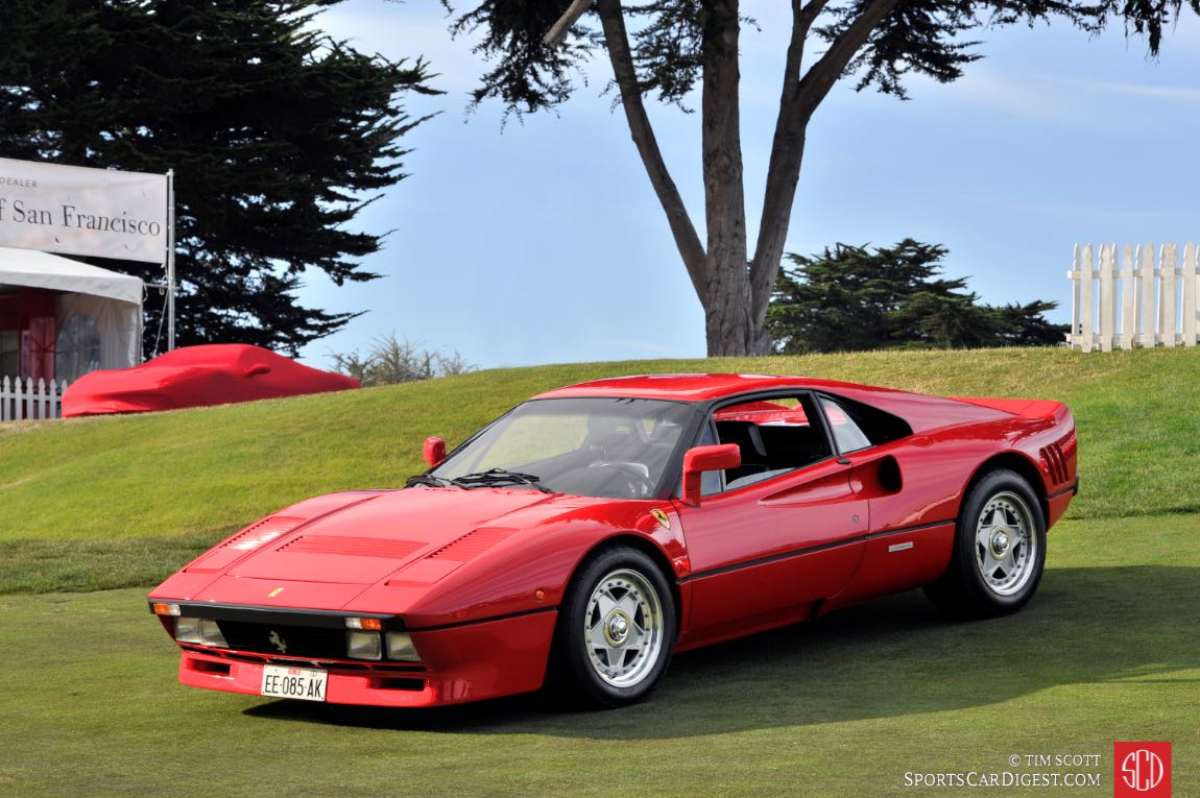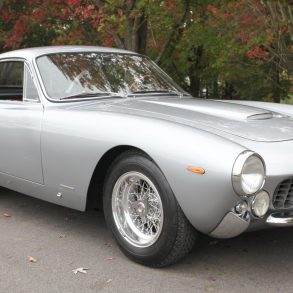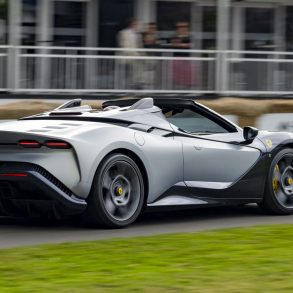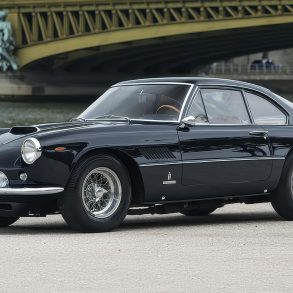In the Ferrari world, the GTO nameplate signifies a distinguished breed of Prancing Horses. Always built in limited numbers and for a special purpose, the GTO cars don’t just wear a badge, but proudly display it as a manifestation of honor. In fact, before the Ferrari 288 GTO, just one more car carried the Gran Turismo Omologato name. It was the Ferrari 250 GTO, the most prominent racing Ferrari of the 1960s, and the most valuable collector car in the world.
Just like its progenitor, the Ferrari 288 GTO was built with the goal to race, alas it never made its way to the tracks. Still, it is a quintessential 1980s Cavallino and one of the greatest, most important cars in Ferrari’s stable filled with purebloods.
This Ferrari flagship was unveiled at the 1984 Geneva Motor Show to a warm response from the automotive industry. At that point, no other company could ever match the finessed performance of the 288 GTO. The Omologato was the fastest car Ferrari ever put into production and a glorious manifestation of refined power.
History of the GTO
The first and one of just three Ferraris to ever bear the GTO medal came from the glorious 250 family. This series of exquisite V12-powered cars from Maranello spawned from the early 1950s to mid-1960s and relates to both grand touring road cars and top tier racing machinery.

During said period, there were several memorable iterations of the racing 250 prototypes, but none of them had an impact like the Ferrari 250 GTO.
Manufactured in a total of 36 examples from 1962 to 1964, the Ferrari 250 GTO was built solely for racing in the FIA Group 3 Grand Touring category and was raced by both Ferrari’s factory team and privateers. It was perhaps the most handsome coupé from Maranello and the roaring 296 horsepower Tipo 168/62 Colombo V12 made it a formidable force on the race tracks around the world.

Combine racing provenance with the beauty of its body designed by Giotto Bizzarrini and Sergio Scaglietti and you’ll get the most coveted classic car of all time!
As of today, the Ferrari 250 GTO is the most expensive collector car in the world with the 1964 Tour de France-winning chassis No. 4153 GTO being sold for $70 million in 2018.

Background
Given the high benchmark of the 250 GTO and the fact that the interest in scarce Ferraris flared up in the late 1970s, the heir had much to live up to. Paradoxically, the growing demand for pedigreed classic Ferraris came hand in hand with the softening and the gentrification of then-new cars which lost ground in touring racing, thus its decade-long appeal.
Faced with an identity crisis which could possibly ruin the carefully cultivated image of a challenging, yet highly capable and rewarding sports car, Enzo Ferrari had to forge ahead and develop a leading-edge automobile that announced Ferrari’s return to the roots.

The company decided to introduce a new GTO, a car evocative of the past, yet prepared to triumph over the contemporary competition on the tracks.
At that point in time, Ferrari was focused on Formula One, turning away from touring and endurance racing. Moreover, Enzo never really ran major rallying projects: the closest Ferrari got to the FIA World Rally Championship was through lending the engines to Lancia for the Stratos.
But, since Group B gained momentum, Ferrari also explored the possibility to run its factory team in the most experimental racing series of the era.
The Group B regulations were added for the 1982 season with only some restrictions and allowing practically unlimited power. Vehicles could be mid-engined two-seaters and companies only needed to produce 200 examples that displayed no more than a passing resemblance to showroom models to meet minimal homologation obligations.

Ferrari’s initial idea was to rebuild the Ferrari 308 GTB, but FIA declined the intention, leaving Ferrari with the option to build a new car.
The development soon commenced under the highly regarded racing engineer Nicola Materazzi. At first, Ferrari still wanted to use up most of the mechanics from the 308, but since Enzo figured that the clients will pay for the new ultimate Ferrari regardless of the final price, the development and manufacturing cost didn’t matter much and not many of the 308 were left by the end of the development process.
The new GTO just visually relied on the 308 GTB, but it was a whole heap more both on the surface and under the shell.

Body and Design
The Ferrari 288 GTO shared the base construction principle with the 308 GTB. It was built on a steel tubular frame, however the panels were constructed in various lightweight materials. The fenders and quarter panels were made of fiberglass composite, the doors were aluminum while Kevlar and carbon fiber were used for the roof, the lower front spoiler and rear valance.

From afar, the 288 GTO indeed looked like the 308, but Leonardo Fioravanti redesigned it for a more aggressive presence that was more functional than cosmetic.
The 288 GTO was shorter than the 308, yet its wheelbase grew 200 mm. The newly designed flared body adjusted the proportions, but was mainly built to accommodate wider wheels: 8-inch in the front and 10-inch in the back.

As a result of thorough wind testing, the GTO got an aerodynamically efficient kit, with the front bumper sporting additional driving lights and a deeper front air dam, further differentiating it from the 308.
As a final touch, Fioravanti included a few nods to the original 250 GTO. The 1960s car had sets of vertical cooling vents on the front fenders, but since the engine of the 288 GTO was mid-mounted, the designer relocated this functional feature behind the rear wheels. On top of that, the discreet aerodynamic wing was also a functional tribute to the pioneering Gran Turismo Omologato.

The use of lightweight materials lowered the center of gravity and significantly improved handling, and so did the increased wheelbase. Despite the overall growth in outside dimensions, the GTO weighed 2,555 lb, a whole 530 lb less than the 308 GTB which utilized traditional construction processes and materials.

All 272 of the 288 GTO were painted red by Ferrari, however, Ferrari-associate Pininfarina painted a prototype in yellow, although this was conducted post-production.
It could be argued that the Pininfarina job is “done by Ferrari” being Ferrari’s official coach-builder. Most enthusiasts recognize the “yellow GTO” and Ferrari has given it Clasiche Certification.

Engine
In developing the 288 GTO’s powerhouse, Materazzi took the proven Dino V8, applying major changes to push it to the then-current maximum.
In the 308 GTB, the Tipo F106 V8 displaced exactly 2,927 cc, but for the 288 GTO, the engine was debored to 2,855 cc, twin-turbocharged and renamed F114B 000.
The engine utilized dual overhead camshafts with Nikasil-lined heads, 32 valves in total, Weber-Marelli fuel injection, flat top pistons, lightweight connecting rods, a magnesium alloy sump and forged steel crankshaft.

The changes didn’t stop there though, as Materazzi laid the engine down longitudinally inside the aluminum-enclosed compartment, opposed to 308 GTB’s transverse placement. The longitudinal mounting allowed for more space for the twin-turbocharging setup.
Ferrari already cut its teeth with forced induction in Formula One and Materazzi was a prolific turbocharging specialist, so he decided to change the 288 GTO’s setup from KKK turbos used in F1 racing to twin parallel Japanese-built IHI turbochargers set at 0.8 bar, with top-mounted dual Behr intercoolers.

The result was truly stunning: 400 bhp at 7,000 RPM, 366 lb-ft from 3,800 RPM, granting a 0-60 acceleration in just 4.9 seconds and a top speed of 189 MPH.
Transmission
The shuffled internals behind the passenger compartment meant that the transmission moved behind the engine. To ensure optimal weight and resistance, the transmission and the differential were housed in aluminum alloy and magnesium cases. The five-speed gearbox followed the racy dogleg pattern.

Wheels, Brakes and Suspension
To handle the ferocious engine and keep the 288 GTO gripping the road, Ferrari outfitted the 288 GTO with Goodyear NCT 225/55 VR16 front and 255/50 VR16 rear tires. The high performance rubber was mounted on two-piece, five-spoke Speedline wheels with a racing-spec central hub. As previously said, the wheels measured 16×8 inches in the front and 16×10 in the back.

Superb stopping power of the 288 GTO was granted via Brembo disc brakes measuring 12.05 inches at the front and 12.2 inches at the rear. The rotors are gripped by two-piston calipers via a dual-channel, servo-assisted hydraulic system, with automatically regulated braking on both axles.
For maximum grip and stability, featured a fully independent suspension with unequal-length tubular steel wishbones with coil springs and manually adjustable Koni shocks. On top of that the 288 GTO was fitted with both front and rear anti-roll bars, further stiffening the chassis and ensuring better balance in the corners.
Interior and Comforts
Though it was built with performance in mind, the 288 GTO was still a Ferrari, so a dose of restrained luxury was still present.

Suede-wrapped dashboard, carpeting, and leather seats came as standard with many of the 288 GTOs fitted with optional extras such as air conditioning, power windows, and cassette stereos. The 288 GTO example above shows red-on-black seats, giving the GTO an even greater racing appeal.
At the time, one couldn’t ask more from a Ferrari, and one couldn’t complain really, since the immersive interior with a gated manual shifter was all that a Ferrari owner really asked for.

Specifications of the 288 GTO
| Engine | 2,855 cc, twin-turbocharged V8 |
| Transmission | Five-speed manual |
| Power | 394 bhp @ 7000 rpm |
| Top Speed | 189 mph |
| Acceleration | 0 – 60mph in 4.9 seconds |
| Front Brakes | Ventilated discs (306mm) |
| Rear Brakes | Ventilated discs (310mm) |
| Dry Weight | 1161kg (2560 lbs) |
Valuation of the Ferrari 288 GTO
| Condition | Value |
|---|---|
| Concours | $2,750,000 |
| Excellent | $2,350,000 |
| Good | $2,100,000 |
| Fair | $1,900,000 |
288 GTO Evoluzione
In the early 1980s, both Porsche and Ferrari had big plans to dominate the Group B with the 959 and GTO respectively. The regulations stipulated that 200 cars should be built, followed by 20 more Evolution copies each year. That’s how and why Ferrari started developing the 288 GTO Evoluzione.

The utmost evolution of the 288 GTO was manufactured by Michelotto, an outside partner in Padova and while this car was based on the GTO, it was significantly improved. The tubular steel skeleton was thinned down and reinforced with composite materials, resulting in construction almost halfway lighter than the original, but three times stiffer.
At first, the 288 GTO Evoluzione testing mule had the standard 400-horsepower Tipo F114B V8 unit, followed by two more exotic engines mounted in the later variants of the car.

The first was the F114 CR V8, the unit which gained 530 horsepower at 7,500 RPM thanks to increased boost pressure and upped engine compression. The dual parallel IHI turbochargers were raised to 1.4 bar, while the engine ran on 7.8:1 compression. This engine could be traced to October 1984 and was just a step towards the most powerful iteration of the 288 GTO.

In September 1985, the engineers mounted a Tipo F114 CK, a highly modified unit with new inlet manifolds, high lift camshafts, a revised Magneti Marelli ECU and beefier turbochargers running at 1.7 bar.
With this engine placed in the middle, the Ferrari 288 GTO Evoluzione had monstrous 650 horsepower at screaming 7,800 RPM, resulting in a 0-60 sprint in less than three seconds and the top speed of over 225 MPH!
This variant of the Evoluzione had a fully synchronized five-speed manual gearbox with twin plate Borg & Beck clutch and a 45% LSD.
Similar to the civilian outing, the suspension of the Evoluzione was all-round independent with coil springs, co-axial Koni dampers and beefy, race-ready anti-roll bars. Extra power was handled via larger Brembo ventilated rotors and stronger two-piston calipers.
At first, the Evoluzione was fitted with five-spoke 16-inch lightweight OZ Racing wheels, 8-inch wide in the front and 12.5 inches in the back. Later examples sported 17-inch and 18-inch multispoke Speedline wheels. The rims of the 288 GTO Evoluzione were wrapped with Michelin Racing rubber.

Finally, there’s the visual aspect of the 288 GTO Evoluzione. Fioravanti’s original design was completely covered by a new and overly dramatic body kit with all focus on functionality. The Evoluzione was wider, lower and shorter than the GTO while composite materials were used to an even greater extent, leaving only the cabin closely similar to one on the civilian counterpart.
The front fascia featured curved pop-up headlights with rectangular auxiliary lights and vertical turn signals sitting below. A large rectangular patterned grille and brake cooling ducts greatly added to the drama of the Evoluzione’s front end. Two NACA ducts dominated the hood, pushing fresh air into the cabin. This design feature later became a trademark of the F40, and now you know where it came from.

From aside, the trademark air intakes grew significantly and were joined by smaller brake cooling intakes, another functional element fully embraced on the F40. More NACA ducts were on the rear fenders which now featured four functional slits.
As on a proper race car, the whole rear end consisted of one lightweight panel that could be easily lifted to gain access to the engine compartment. Finally, the Michelotto-designed squared rear end had a grid of horizontal openings and a prominent adjustable trunk wing with a Gurney flap sitting underneath.
The interior was nowhere near as comfortable as the one in the 288 GTO. After all, the Evoluzione was a proper race car study.

The only recognizable element from the civilian GTO was the instrument cluster, with the seats replaced by ultra-lightweight buckets and all the trim and upholstery gone, leaving only naked panels, an exposed fuse box and tall composite sills encapsulating and protecting the driver.
In the end, it’s normal that the looks of the 288 GTO Evoluzione seem oddly familiar to the ultimate 1980s poster car. By 1985, the future of the Group B was already under question, but with the Group B ambitions officially scrapped due to its demise in 1986, the only choice for Ferrari was to see how far the 288 GTO platform could be improved.
That’s why the initial Evoluzione was converted into a Ferrari F40 test mule and many design elements of the 288 GTO Evoluzione were carried over to the production F40 supercar, albeit toned down. Moreover, the raw and exposed interior of the F40 was also inspired by the Evoluzione.
In addition to the original prototype, Ferrari produced five examples of the 288 GTO Evoluzione.
One (chassis 70205) remained in Ferrari’s possession, while the others were offered to the most prominent customers. The second development car (70167) went to a French collector ,Pierre Bardinon. Three final examples were built in 1988 and the first was sold to Jacques Swaters (79888), whereas the other was bought by Enrico Capitanio (79887). The fifth and final example (79889) went to the Sultan of Brunei.
The 288 GTO Legacy
Although the 288 GTO didn’t fulfil its primary purpose due to a higher power, it marked the new direction for Ferrari. Soon after the 288 GTO, Porsche followed with the 959, another Group B-intended project, prompting Enzo to come back with the F40, giving birth to the ultimate 1980s supercar rivalry.

The F50, the Enzo, and the LaFerrari all followed the path of the original supercar duo paved years before. The 288 GTO not only started the lineage of Ferrari supercars but was also the scarcest of them all. Ferrari planned to build 200 examples strictly for homologation, but the high demand and the departure from rallying ambitions prompted 72 more examples, equating to a total of 272. If you consider the one official pre-production prototype, the total is 273.
The rarity and the significance for the company all translate to the 288 GTO’s price on the collector car market. Today, the 288 GTO is among the most valuable post-1960s Ferraris, achieving prices north of the $3 million mark, a significant premium over the original sticker price of $84,000 even with inflation adjustments ($213,088 in today’s money).











The greatest post 1960s Ferrari. Cherished by true enthusiasts. Not for YouTubers, rappers or Celebrities looking for a status symbol. My all time favorite Ferrari.